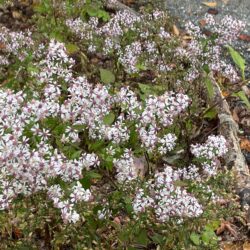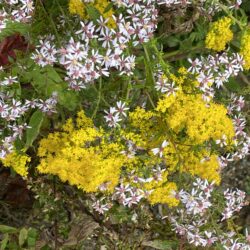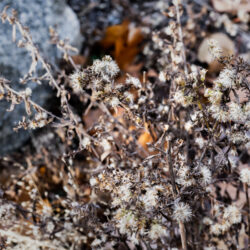Etymology
Symphyotrichum is from the Greek symph meaning coming together and trich meaning hair (in possible reference to the flower anthers); lateriflorum is a combination of the Latin words for side and flower in reference to the fact that the flowers of this species generally are located on one side of the stems, hence the sometimes-used common name of side-flowering aster.
Native Habitat
Forest margins, stream borders, low wet woods, meadows, fields, and roadsides.
Garden Uses
This aster is useful in borders as well as woodland areas as a mass or group, or as a filler. Plants may be used as a perennial hedging plant along walkways or paths. This is a good choice for a wildlife garden or meadow.
Overview
Calico Aster is an herbaceous, somewhat bushy perennial that typically grows to 2 - 3’ tall with a slightly smaller spread. The species gets its common name from the variety of colors of its blossoms' central disks on the same plant.
Leaves and Stems
Long horizontal branches spread out from the main stem, each clad with rough, narrow, lanceolate, dark green leaves that are alternately arranged with toothed margins. Leaves turn coppery in late summer. Lower leaves grow to 1-1/2” wide by 6” long. Leaves significantly decrease in size as they ascend the stems. Stems are single or multiple from the base, erect to ascending or sometimes arching, initially green often turning red later in the season, and covered in soft, white hairs, though may become hairless on the lower stem.
Flowers
Loose clusters of multiple flowering heads are found concentrated mainly on one side of the widely spreading branches of Calico aster. Small whitish flowers (each to 1/2” across) bloom in clusters along the branches from mid/late August into October. Each flower has 8-15 white to purple-tinged rays which surround a central disc of 8-16 tiny tubular disk flowers which mature to purplish-red after being pollinated.
Fruit/Seed
Fruit is a dry seed (achene) with a tuft of dull white to pinkish hairs to carry it off in the wind.
Animal Associates
Calico Aster attracts bees and butterflies. Is the larval host for pearl crescent (Phycoides tharos) and checkerspot butterflies.
Propagation
May be grown from seed or rhizomes.
Ethnobotanical Uses
None found.
Garden Location
Library Garden, Performance Hall Garden, Teaching Garden (see garden map)
Sources
Lady Bird Johnson Wildflower Center
Plant Profile by Kathy Kling



